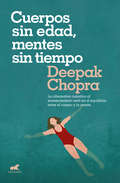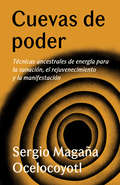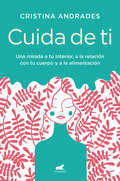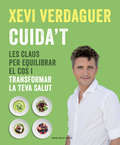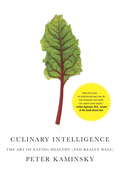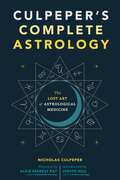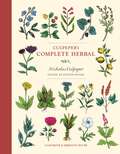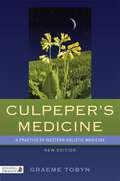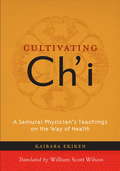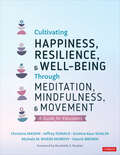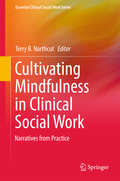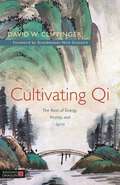- Table View
- List View
Cuerpos sin edad, mentes sin tiempo: La alternativa cuántica al envejecimiento está en el equilibrio entre el cuerpo y la mente (Spanish Ser.)
by Deepak ChopraEl libro fundamental de Deepak Chopra. En este long seller indiscutible, el gran maestro Deepak Chopra nos muestra que el pasado y el futuro son proyecciones mentales y que, si logramos liberarnos de ellas, podremos vivir la experiencia de un cuerpo sin edad y una mente sin tiempo. Transformaremos así nuestro cuerpo, creando las condiciones para la longevidad y preservando el equilibrio de la vida. Este libro nos brinda, pues, las herramientas para modificar nuestra percepción sobre la edad y conservar la vitalidad, la belleza y la creatividad.
Cuevas de poder
by Sergio Magaña OcelocoyotlAhora disponible en español, este libro poderoso y único realiza un nuevo acercamiento a una antigua tradición cuyo objetivo es traer curación y resolución a nuestros problemas más importantes en cuanto a salud, emociones, abundancia e iluminación. Muchas personas en el mundo están buscando hoy sus verdaderas identidades. Los antiguos mayas creían que somos capaces de acceder a nuestra verdad interior a través de nuestro espíritu, nuestros instintos y nuestro subconsciente, todo lo cual habita en lo que ellos llaman las siete "cuevas del poder", o chakras. Sanar esas cuevas internas, según las creencias mayas, nos permite mejorar y revitalizar cada área de nuestras vidas. En Cuevas de poder, el mundialmente reconocido sanador Sergio Magaña nos revela este conocimiento secreto de la antigua tradición tolteca, ya casi olvidado. El autor comparte poderosos y prácticos ejercicios de curación, rejuvenecimiento, manifestación e iluminación, mientras también aborda áreasrelacionadas como la numerología mexicana, la consulta astral, el trabajo onírico, la acupuntura, la energía rotacional y las técnicas mexicanas Kundalini.
Cuevas de poder: Técnicas ancestrales de energía para la sanación, el rejuvenecimiento y la manifestación
by Sergio Magaña OcelocoyotlAhora disponible en español, este libro poderoso y único realiza un nuevo acercamiento a una antigua tradición cuyo objetivo es traer curación y resolución a nuestros problemas más importantes en cuanto a salud, emociones, abundancia e iluminación. Muchas personas en el mundo están buscando hoy sus verdaderas identidades. Los antiguos mayas creían que somos capaces de acceder a nuestra verdad interior a través de nuestro espíritu, nuestros instintos y nuestro subconsciente, todo lo cual habita en lo que ellos llaman las siete "cuevas del poder", o chakras. Sanar esas cuevas internas, según las creencias mayas, nos permite mejorar y revitalizar cada área de nuestras vidas. En Cuevas de poder, el mundialmente reconocido sanador Sergio Magaña nos revela este conocimiento secreto de la antigua tradición tolteca, ya casi olvidado. El autor comparte poderosos y prácticos ejercicios de curación, rejuvenecimiento, manifestación e iluminación, mientras también aborda áreas relacionadas como la numerología mexicana, la consulta astral, el trabajo onírico, la acupuntura, la energía rotacional y las técnicas mexicanas Kundalini.
Cuida de ti
by Cristina AndradesCuida de ti te acerca, de manera instructiva, a los múltiples factores que inciden en tu forma de tratarte, de alimentarte y en la relación que establecemos con nuestro cuerpo, siempre desde una mirada respetuosa hacia ti misma. En este nuevo libro, Cristina Andrades va un paso más allá de la psicología relacionada con la conducta alimentaria y del tratamiento de los aspectos psicológicos que influyen en nuestra relación con la comida para ofrecernos conceptos clave como el autocuidado desde la autoestima hasta el pensamiento crítico ,centrándose en cuestiones como la autoexigencia y la autoimagen, cuyo buen entendimiento es de vital importancia para el bienestar personal. Con un tono sencillo y un enfoque práctico, la autora te ayudará a conocer más de ti misma y a comprender qué papel juegan todos estos aspectos en tu salud física, emocional y psicológica.
Cuida tus plantas para que ellas cuiden de ti: Despierta tu instinto planternal
by Nena Von FlowUn cuaderno ilustrado para cultivar nuestro bienestar a través del cuidado de las plantas. En entornos rurales o urbanos, en balcones, terrazas o jardines, el contacto con las plantas nos ayuda a dejar a un lado las rutinas y el estrés de cada día. Este libro ilustrado es una invitación a conectar con el mundo natural que nos rodea, a sentir su poder sanador y transformador. A través de consejos prácticos, proyectos creativos y reflexiones inspiradoras, Nena Von FLow nos anima a compartir con las plantas nuestro día a día y a descubrir los efectos positivos que tienen en nuestra salud. Cuida tus plantas para que ellas cuiden de ti celebra el potencial de la naturaleza para reparar, sanar y transformar nuestro estado de ánimo.
Cuida't: Les claus per equilibrar el cos i transformar la teva salut
by Xevi VerdaguerXevi Verdaguer, autor de Transforma la teva salut, revela en el seu nou llibre una manera revolucionària d'entendre el funcionament del cos. Un mètode que transformarà la nostra salut i la millorarà radicalment. Sovint sentim molèsties que intentem alleujar amb medicaments: migranyes, dolors crònics, fatiga, dolors menstruals, contractures, ansietat... En Xevi Verdaguer, especialista en PsicoNeuroImmunologia, ens apropa a la visió de la medicina integrativa i ens mostra què podem fer per solucionar aquestes dolències fàcilment, i alhora ens dona les claus per entendre millor el nostre cos, aprendre a escoltar-lo i convertir-nos així en els protagonistes de la nostra salut. Aquest llibre ens ofereix els coneixements i consells d'en Xevi Verdaguer de manera senzilla, clara i pràctica per tal que els puguem aplicar al nostre dia a dia. Coneixerem els aliments recomanats i els que hem d'evitar menjar per a cada dolència, aprendrem com combinar-los amb menús equilibrats i com cuinar-los amb receptes saboroses i gens complicades, creades per nutricionistes.
Cuidado de la piel: Preserva el órgano más grande del cuerpo (Cómo... #96)
by Owen JonesEspero que encuentres esta información de ayuda, útil y beneficiosa. La información contenida en este ebook sobre varios aspectos del cuidado de la piel ha sido organizada en 17 capítulos de 500-600 palabras cada uno. Espero que sea de interés para aquellos que quieran mejorar o mantener su piel. Y como extra, eres libre de usar este contenido en tu propia web, blog o newsletter, aunque es mejor que lo redactes con tus propias palabras. También podrías dividir el libro y revender los artículos. De hecho, lo único para lo que no tienes permiso es para distribuir el libro del mismo modo que te ha llegado. Si tienes algún comentario, por favor déjaselo a la compañía a la que le compraste el libro.
Cuidados Paliativos: Quando Cuidar é um Privilégio
by Ann RichardsonA morte é um tema inquietante, desconfortável. Ninguém gosta de pensar como será o seu fim de vida, mas todos esperamos que seja cheio de paz e tranquilidade, com tempo de nos despedirmos das pessoas que nos são mais queridas. “Cuidados Paliativos: Quando Cuidar é um Privilégio” transporta-nos para os bastidores dos cuidados em fim de vida, descrevendo os esforços dramáticos de enfermeiros, médicos, psicólogos, capelães e outros – incluindo um chef dedicado – que tudo fazem para minorar o sofrimento e a ansiedade de pacientes e familiares. Talvez este livro lhe interesse caso seja curador de alguém que ama. Talvez encontre aqui as respostas caso tenha dúvidas se este é o trabalho indicado para si. Ou talvez este livro lhe interesse porque descreve a humanidade no que tem de melhor. Este livro foi escrito para si. ALTAMENTE RECOMENDADO pela Associação Médica Britânica (2008) "Um enriquecimento do cânone da literatura de narrativas pessoais sobre a doença, a morte e o sofrimento... A simples reflexão sobre o conteúdo sensível e complexo deste livro vai ainda surtir efeito, muito depois da sua leitura.” Fórum sobre Enfermagem Oncológica, Escola Real de Enfermagem "Um livro de fácil leitura, que irá surpreender muitos leitores pela leveza com que o tema é abordado. Um livro reconfortante, cheio de humanidade. Recomendo a qualquer pessoa que se preocupa com a temática ou presta cuidados paliativos a um ente querido em fim de vida." Dr Nansi-Wynne Evans, Médica Gener
Cuidados da Pele: Algumas dicas para cuidar do maior órgão do seu corpo (Como se faz... #96)
by Owen JonesCuidados da Pele Algumas dicas para cuidar do maior órgão do seu corpo Sua pele é o maior órgão do seu corpo, então cuidar dela faz muito sentido! Espero que você ache as informações prestativas, úteis e vantajosas. A informação deste ebook com vários aspectos sobre o cuidado da pele foi organizada em 17 capítulos de aproximadamente 500 a 600 palavras. Espero que este ebook seja de interesse para aqueles que gostariam de melhorar ou conservar sua pele. Como bônus adicional, concedo a você a permissão de utilizar o conteúdo em seu próprio website ou em seus próprios blogs e newsletter, embora seja melhor se você o reescrever em suas próprias palavras primeiro. Você também pode dividir o livro e revender os artigos. Na verdade, o único direito que você não possui é de revender ou de doar o livro da maneira como ele foi entregue a você.
Cuina natural
by Adam MartinSI VOLS MENJAR SA I BÉ, AQUEST ÉS EL TEU LLIBREEn aquestes 101 receptes de cuina natural trobaràs àpats quecompleixen cinc requisits:- Fàcils de menjar- Fàcils de digerir- Nutritius- Saludables- Bons!Cuina natural és un recull de receptes saboroses, innovadoresi fàcils de preparar, elaborades amb productes ecològics, deproximitat i de temporada. També hi trobareu tècniques perreinterpretar en clau saludable els plats de sempre i per crear-ne de nous. A més de satisfer els nostres sentits, Cuina natural té en compte els efectes dels aliments en l'organisme, i la combinació és perfecta: ens permet menjar plats deliciosos vetllant alhora per la salut i trenca aquella dicotomia absurda que diu que els plats o són bons o són saludables.Endinsa't en la cuina natural: t'alimentaràs com cal,et sentiràs millor, estaràs més sa i et lleparàs els dits.
Cuisine Vegetarienne: 25 Délicieuses Recettes Végétaliennes – Livre De Recettes Végétaliennes (Vegan Recettes Français)
by Julie Nantel David C JamesDe plus en plus de personnes limitent la viande, le poisson, l’œuf, le lait et cetera pp. Manger végétarien, c’est aussi réveiller nos papilles parfois engourdies par une alimentation quotidienne souvent trop standardisée. Cette collection, servie par une maquette claire, permet d'accéder avec peu d'ingrédients, à l'essentiel : une réalisation imparable et sans faille pour se régaler sans complexe d'une cuisine simple, saine et savoureuse. Elle vous amène à découvrir dans ce titre des recettes réjouissantes pour les végétariens.
Cuisine biologique pour bébés et tout-petits de Kasani: Des aliments frais et faits maison pour un départ sain
by Adidas WilsonOn a 42 chapitres de recettes savoureuses que tous les parents adoreront. Les recettes sont simples et faciles à lire. Les dîners de famille comprennent quelques recettes savoureuses que toute famille appréciera. Kasani’s Baby and Toddler Cookbook est votre guide pour ces premières années importantes de manger. Trouvez les éléments constitutifs du démarrage de votre enfant sur les aliments solides, comment reconnaître les allergies alimentaires et des façons faciles de cuisiner en vrac. Les recettes passent des purées à ingrédients simples aux mélanges multi-saveurs comme le combo légumes de jardin et la maille de bleuets de betteraves. Ce livre comprend également des informations sur les allergies orales ainsi que les meilleurs ustensiles gratuits bpa pour les enfants. Les aliments de stade 1 et 2 sont inclus. La plupart peuvent être faites à l’avance et congelées, beaucoup sont facilement adaptés pour les goûts adultes, et tous comprennent la pleine valeur nutritive. Veuillez consulter votre pédiatre à l’avance pour les allergies alimentaires également incluses en profondeur. Exemptes de pesticides, d’hormones, d’OGM et d’additifs, ces délicieuses purées favorisent un système immunitaire solide et une croissance saine.
Cuisine pour régimes spéciaux: Français
by Nancy RossVOUS VOULEZ APPRENDRE 100 RECETTES DE CUISINE POUR RÉGIMES SPÉCIAUX AVEC DES INSTRUCTIONS ÉTAPE PAR ÉTAPE? DÉCOUVREZ DE DÉLICIEUSES RECETTES DE RÉGIME CÉTOGÈNE, DES RECETTES DE RÉGIME MÉDITERRANÉEN ET DES RECETTES DE RÉGIME ALCALIN DANS UN SEUL LIVRE! Voici un aperçu de certaines des recettes cétogènes que vous apprendrez... Bars pour le petit-déjeuner Petit déjeuner Pizza Scones de bleuets Suprême de poulet orange Casserole d’épinards et de bacon Aubergine Parmesan Salade thaïlandaise Fajitas au poulet Saucisses et purée de panais Poulet mexicain Côtelettes d’agneau faciles Beaucoup, beaucoup, plus! Voici un aperçu de certaines des recettes du régime méditerranéen que vous apprendrez... Crêpes aux figues Gratin d’oeufs Salade de tomates Salade de poulet grillé Salade de légumes Polenta Salade de roquette aux poires Salade de feta à la pastèque Soupe Orzo Lasagnes méditerranéennes Pâtes aux fruits de mer Moules à vin blanc Beaucoup, beaucoup, plus! Voici un aperçu de certaines des recettes de régime alcalin que vous apprendrez... Crêpes aux pommes Brouillage de tofu Granola à la mangue Salade de chou frisé et de quinoa Beignets de courgettes et de patates douces Enveloppement à l’avocat Poivrons aux œufs Pâtes aux légumes rôties Aubergine marinée Saumon aux épinards et champignons Poivrons farcis Beaucoup, beaucoup, plus!
Culinary Intelligence
by Peter KaminskyFor many of us the idea of healthy eating equals bland food, calorie counting, and general joylessness. Or we see the task of great cooking for ourselves as a complicated and expensive luxury beyond our means or ability. Now Peter Kaminsky--who has written cookbooks with four-star chefs (for example, Daniel Boulud) and no-star chefs (such as football legend John Madden)--shows us that anyone can learn to eat food that is absolutely delicious and doesn't give you a permanently creeping waistline. Just a couple years ago, Kaminsky found himself facing a tough choice: lose weight or suffer the consequences. For twenty years, he had been living the life of a hedonistic food and outdoors writer, an endless and luxurious feast. Predictably, obesity and the very real prospect of diabetes followed. Things had to change. But how could he manage to get healthy without giving up the things that made life so pleasurable? In Culinary Intelligence, Kaminsky tells how he lost thirty-five pounds and kept them off by thinking more--not less--about food, and he shows us how to eat in a healthy way without sacrificing the fun and pleasure in food.Culinary Intelligence shows us how we can do this in everyday life: thinking before eating, choosing good ingredients, understanding how flavor works, and making the effort to cook. Kaminsky tells us what we need to give up (most fast food and all junk food) and what we can enjoy in moderation (dessert and booze), but he also shows us how to tantalize our tastebuds by maximizing flavor per calorie, and he makes delectably clear that if we eat delicious, flavorful foods, we'll find ourselves satisfied with smaller portions while still enjoying one of life's great pleasures.
Culinária para Dietas Especiais: Coleção 3 em 1
by Nancy RossQuer aprender mais de 100 receitas para dietas especiais com instruções passo a passo? Descubra deliciosas receitas para a dieta cetogênica, mediterrânea e alcalina, tudo em só um livro! Algumas das receitas que você vai encontrar: Barrinhas de café da manhã, pizza, muffins, salada tailandesa, frango mexicano, salada de tomate, macarrão de frutos do mar, polenta com vegetais, mexilhões ao molho de vinho, o melhor bife do mundo, salada de quinoa, bolinhos inegrais, musse de chocolate, cozido de tofu e muitas outras! Mantenha-se na dieta com mais facilidade, aprendedo pratos deliciosos e saudáveis!
Culpeper's Complete Astrology: The Lost Art of Astrological Medicine
by Nicholas CulpeperDelve into the astrological herbalism of Nicholas Culpeper, the 17th-century physician, herbalist, and astrologer whose writing about health and herbs made a mark on medicine that resonates to the present day. His astute eye, keen wit, and encyclopedic knowledge led him to create his definitive English Physitian, more commonly known today as Culpeper's Complete Herbal. Planetary influences were key to his understanding of herbal medicine. In his philosophy, each plant is governed by a planet, and the time at which a person takes to their sickbed is significant to their diagnosis and healing. His Semeiotica uranica, or, An astrological judgment of diseases from the decumbiture of the sick was a seminal early work of medical astrology and is published here as a historical document of great fascination to astrologers as well as to historians of herbalism and medicine. This edition includes modernized English spelling and expert guidance on how to decipher the work and consider Culpeper's influence in modern context.Also included are a foreword by Alice Sparkly Kat, author of Postcolonial Astrology, and an introduction by Judith Hill, author of Medical Astrology.
Culpeper's Complete Herbal: A Compendium of Herbs and Their Uses, Annotated for Modern Herbalists, Healers, and Witches
by Nicholas CulpeperDescription of Microcosm's Fall 2022 edition: For the last 350 years, since the reign of Elizabeth I, Nicholas Culpeper's encyclopedic compendium of the uses and properties of medicinal herbs has been unrivaled in completeness or charm. From Adder's Tongue to Yellow Loosestrife, each of the 316 herbs is described in detail, along with its "government and virtues," remedies and cautions—much of which has held up remarkably well through many advancements in scientific understanding. This new edition has been updated and annotated by Dr. J.J. Pursell, author of The Herbal Apothecary. Dr. Pursell has added modern scientific names, usage notes and contraindications, and a fascinating new introduction that frames Culpeper's remarkable life and work through a modern lens. This timely upgrade to a classic work retains the brilliance of the original while making its valuable information available to new generations of herbalists, house witches, students, and anyone who wants to know more about the plants growing in their backyard.
Culpeper's Complete Herbal: Illustrated and Annotated Edition
by Steven Foster Nicholas CulpeperA revised and refreshed edition of Culpeper&’s classic book on herbal remedies. &“[An] updated and beautifully designed guide . . . &” —Booklist For more than 360 years, Nicholas Culpeper&’s historic guide to herbal remedies has been THE definitive book on the subject. Culpeper, an English herbalist, is the author of the bestselling herbal guide of all time. He offered valuable and sometimes unusual advice on using, gathering, and preparing herbs. Now, this beautifully illustrated new edition, edited and with commentary by acclaimed US herbalist and bestselling author Steven Foster, combines the charm and information of Culpeper&’s original seventeenth-century text with up-to-date, modern, practical usage. It includes details about where to find each herb, astrology, and medicinal benefits.[back flap] Bestselling author, photographer, consultant, and herbalist Steven Foster has forty years of experience in the herbal field. He started his career at Sabbathday Lake (Maine) Shaker Village Herb Department—America&’s oldest herb business, dating to 1799. Foster is the author or coauthor of eighteen books, including the Peterson Field Guide to Medicinal Plants and Herbs of Eastern and Central North America, 3rd ed. (with James A. Duke). Foster is also senior author of National Geographic&’s A Desk Reference to Nature&’s Medicine (with Rebecca Johnson). An acclaimed photographer, his work appears in countless publications. He is a contributing editor to HerbalGram, the journal of the American Botanical Council in Austin, Texas. He lives in Eureka Springs, Arkansas. [back cover] Spectacularly illustrated, this is an annotated edition of Nicholas Culpeper&’s bestselling herbal book on using, gathering, and preparing herbs. With new commentary on modern usage by acclaimed US herbalist and bestselling author Steven Foster supplementing Culpeper&’s seventeenth-century text, it provides information on where each herb can be found, its astrological correlations, and all of its medicinal benefits.
Culpeper's Medicine: A Practice of Western Holistic Medicine New Edition
by Graeme TobynDrawing on the writings of Nicholas Culpeper, the 17th-century herbalist, apothecary and astrologer, this updated, accessible introduction celebrates the holistic medical traditions of the West, and places Culpeper in his appropriate context as one of the forebears of modern holistic medicine and a prophet of the NHS. An extensive new introduction to the work comments on the latest research and developments in the area. The book traces the development of the Western holistic medical tradition from its origins in the natural philosophy of Ancient Greece to the work of Culpeper himself. It describes and explains the relationship between the four elements, the four humours and the four constitutional types: sanguine, choleric, melancholic and phlegmatic, as well as explaining the functional relationships of organs and body systems. The book explores the interconnectedness of psyche (mind) and soma (body) and includes a section on herbal medicine and therapeutics with a study of 20 common herbs, dietary suggestions and uses for culinary herbs. It also provides accessible information on astrology and the importance of the horoscope for holistic patient assessment. The book looks at the holistic approach to the preservation of health and prevention of disease, with explanations of the various disease states, their humoral medical diagnosis and treatment. An authoritative insight into the expanding world of holistic medicine, this book is an indispensable resource for medical herbalists, students of herbal medicine and all those interested in Western holistic medicine and its origins.
Cultivating Ch'i: A Samurai Physician's Teachings on the Way of Health
by William Scott Wilson Kaibara EkikenSamurai are best known for taking life--but here is a samurai doctor's prescription for how to preserve life, and to make yours a long and healthy one. Unlike other samurai of his time, the samurai Kaibara Ekiken (1630-1714) was concerned less with swordsmanship than with how to maintain and nurture the healthy mind and body upon which martial techniques and philosophy depended. While serving as the chief medical doctor and healer to the Kuroda clan, he came to a holistic view of how the physical, mental, and spiritual lives of his patients were connected. Drawing from his medical practice, the principles of traditional Chinese medicine, and his life experience, Ekiken created this text as a guide to sustaining health and stamina from youth to old age. Ekiken's advice regarding moderation, food and drink, sleep, sexual activity, bathing, and therapeutic practices is still amazingly intuitive and appropriate nearly three hundred years after this book was written.
Cultivating Happiness, Resilience, and Well-Being Through Meditation, Mindfulness, and Movement: A Guide for Educators
by Christine Y. Mason Jeffrey Donald Krishna Kaur Khalsa Michele M. Murphy Valerie L. BrownIn chaotic times, a deep breath can bring calm to your classroom. As the pandemic recedes and the world gradually returns to “normal,” it’s more important than ever to make your classroom a place that supports mental health and improves overall wellness. In this book, you’ll discover the why and the how of using techniques to reduce stress, improve executive function, and set the stage for increased memory and attention, better self-regulation, and improved cognition and academic learning. With this practical, research-based guide, you’ll incorporate age- and grade-appropriate meditation, breathing, mindfulness, and secular yoga activities into your teaching, in ways that work for in-person as well as virtual and hybrid settings. Features include Adaptations for special populations, including those who have experienced trauma Recommendations for family involvement in social emotional learning Guidance on self-care for teachers and school staff Data from successfully implemented programs Dozens of illustrations, QR codes, and reflective questions Mindfulness isn’t just a buzzword-it’s a time-tested, teacher-tested technique for reducing anxiety and improving you students’ outcomes. Incorporate it into your classroom and see for yourself how much good a deep breath can do.
Cultivating Happiness, Resilience, and Well-Being Through Meditation, Mindfulness, and Movement: A Guide for Educators
by Christine Y. Mason Jeffrey Donald Krishna Kaur Khalsa Michele M. Murphy Valerie L. BrownIn chaotic times, a deep breath can bring calm to your classroom. As the pandemic recedes and the world gradually returns to “normal,” it’s more important than ever to make your classroom a place that supports mental health and improves overall wellness. In this book, you’ll discover the why and the how of using techniques to reduce stress, improve executive function, and set the stage for increased memory and attention, better self-regulation, and improved cognition and academic learning. With this practical, research-based guide, you’ll incorporate age- and grade-appropriate meditation, breathing, mindfulness, and secular yoga activities into your teaching, in ways that work for in-person as well as virtual and hybrid settings. Features include Adaptations for special populations, including those who have experienced trauma Recommendations for family involvement in social emotional learning Guidance on self-care for teachers and school staff Data from successfully implemented programs Dozens of illustrations, QR codes, and reflective questions Mindfulness isn’t just a buzzword-it’s a time-tested, teacher-tested technique for reducing anxiety and improving you students’ outcomes. Incorporate it into your classroom and see for yourself how much good a deep breath can do.
Cultivating Mindfulness in Clinical Social Work: Narratives from Practice (Essential Clinical Social Work Series)
by Terry B. NorthcutThis practice-focused resource integrates broad therapeutic knowledge with current neuroscience to present vast possibilities for mindfulness in clinical social work. Seasoned practitioners posit mindfulness practice and process as a significant bridge between taking care of self and taking care of others, demonstrating its implications for physical and mental health in personal and professional contexts. Case studies show timeless concepts (e. g. , acceptance) and new mindfulness-based ideas (e. g. , learned helpfulness) in use in individual treatment as well as couples counseling and group interventions. Also attesting to the utility of mindfulness across problems, settings, and practitioner orientations, diverse applications are organized along ten robust lenses, among them: * Beginning with the context: the mind-body conundrum. * Beginning with the body: the neurobiology of mindfulness. * Beginning with the training: training clinicians in essential methods for integrating mindfulness in clinical practice. * Beginning with the clients: mindfully reconciling opposites with survivors of trauma/complex traumatic stress disorders. * Beginning with the symptom: incorporating mindfulness in the treatment of substance misuse. * Beginning with the larger social system: mindfulness and restorative justice. Clinicians and research professionals particularly interested in psychotherapy treatment and mindfulness practice will find Cultivating Mindfulness in Clinical Social Work not only stimulating and intriguing, but also a fresh source of real-world wisdom.
Cultivating Qi: The Root of Energy, Vitality, and Spirit
by Grandmaster Grandmaster Nick Gracenin David W. ClippingerHow can Qi offer you the means, tools and will to live a life of balance? Explaining what Qi is, where it comes from, how we use it, and how we can cultivate it in order to achieve wholeness and balance, this much-needed book combines knowledge and practice to explore all aspects of Qi, including its modern, everyday implications. The book not only covers the history of Qi, but also demystifies the vital philosophies and practices surrounding it. Filled with valuable information on how to recognise and cultivate Qi in order to increase your energetic capacity and return to a more efficient physical, emotional, and psychological state, it also illustrates Qi's central importance in meditation, Taiji, Qigong, and other Internal Arts practices that focus upon its vitality. The author also offers instruction on a number of methods for opening the energy gates of the body to cultivate Qi.
Cultivating Your Microbiome: Ayurvedic and Chinese Practices for a Healthy Gut and a Clear Mind
by Bridgette SheaA holistic guide to improving your gut flora for better physical and emotional health • Explores the influence of the gut microbiome and the mesentery on all other bodily systems, especially the brain and immune system • Explains the central role of the digestive system in Ayurveda and traditional Chinese medicine and how these systems treat the microbiome • Presents herbal remedies, acupuncture and acupressure techniques, and dietary methods to restore balance to your gut flora, including a microbiome reset In traditional medicine, such as Indian Ayurveda and Chinese medicine, the digestive system and microbiome are recognized as the foundation for good health. Our internal flora influences our immune system, brain function, hormonal balance, cravings, sleep, mood, inflammatory response, digestion, nutrient assimilation, and elimination. In this holistic guide to cultivating a healthy microbiome and managing gut health naturally, Bridgette Shea explores digestive functioning from the perspectives of both Western science and traditional medicine. She examines Ayurvedic and Chinese medicine principles on digestion and constitution types. She reveals how, in addition to describing what we now call the microbiome, traditional Chinese medicine also has long recognized the importance of an abdominal organ that modern science has only recently acknowledged: the mesentery, the tissues that connect and support the internal organs. Going beyond probiotics and prebiotics, the author presents practices from Ayurveda and Chinese medicine to reestablish balance in your internal microbiome, support the mesentery, improve digestion and elimination, and restore a clear mind and strong immune system. She explains how to read your symptoms, from brain fog and fatigue to congestion and stool quality, and offers herbal remedies, acupuncture and acupressure techniques, and dietary methods to improve your internal health, including a microbiome dietary reset. Revealing the diverse role that our inner microbial colonies play in keeping us happy and healthy, this book shows that by changing your microbiome, you can greatly improve your physical, emotional, and mental health.
